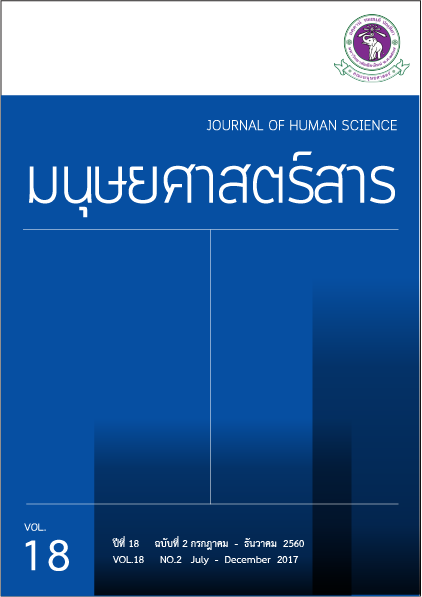แนวโน้มทิศทางการย้ายถิ่นของแรงงานข้ามชาติและการจัดการเพื่อรองรับการรวมกลุ่มประชาคมอาเซียน กรณีศึกษาแรงงานไทใหญ่ ในอำเภอเมือง จังหวัดเชียงใหม่
Main Article Content
บทคัดย่อ
การวิจัยนี้มีวัตถุประสงค์เพื่อศึกษาสถานการณ์และภาพอนาคตของแรงงานชาวไทใหญ่ที่เข้ามาทำงานในจังหวัดเชียงใหม่ ผลกระทบของแรงงานไทใหญ่ที่มีตนเอง ครอบครัวและชุมชน รวมทั้งที่มีต่อเศรษฐกิจ สังคมและวัฒนธรรม ความมั่นคงของจังหวัดเชียงใหม่และแนวทางการบริหารจัดการแรงงานย้ายถิ่นกลุ่มไทใหญ่อย่างมีส่วนร่วมจากกลุ่มแรงงานชาวไทใหญ่เพื่อรองรับการรวมกลุ่มประชาคมอาเซียน โดยใช้ระเบียบวิธีวิจัยเชิงคุณภาพจากมิติภายในสู่ภายนอก เก็บรวบรวมข้อมูลด้วยวิธีการสนทนากลุ่ม สัมภาษณ์เชิงลึก สังเกตการณ์จากผู้นำชุมชน ผู้ประกอบการที่ใช้แรงงานไทใหญ่ ผู้ประกอบการในชุมชนและแรงงานไทใหญ่ในเขตอำเภอเมือง จังหวัดเชียงใหม่ รวมทั้งสิ้น จำนวน 66 คน วิเคราะห์ข้อมูลด้วยวิธีการวิเคราะห์เนื้อหาและจัดเรียงลำดับความสำคัญ จากการศึกษาพบว่า สถานการณ์ในอดีตของชาวไทใหญ่กลุ่มแรกเข้ามาตั้งถิ่นฐานในอาณาจักรล้านนาเชียงใหม่ช่วงคริสต์ศตวรรษที่ 16-19 คือ พ่อค้าวัวต่างชาวไทใหญ่และชาวยูนนาน กลุ่มที่สองอพยพเข้ามาหลังรัฐบาลทหารพม่าปฏิเสธปฏิบัติตามสัญญาปางโหลงในช่วงปลายสมัยสงครามโลกครั้งที่ 2 หลังอังกฤษคืนเอกราชให้กับพม่า ส่วนสถานการณ์ปัจจุบันแรงงานชาวไทใหญ่เข้ามาทำงานในจังหวัดเชียงใหม่เพิ่มสูงขึ้น ด้วยการข้ามพรมแดนบริเวณตะเข็บชายแดนของประเทศไทยและรัฐฉานของสหภาพเมียนมาร์ ลักษณะการเข้ามาส่วนใหญ่ไม่มีการขออนุญาต เข้ามาพักหรือทำงานชั่วคราวในอำเภอเมืองและอำเภอปาย จังหวัดแม่ฮ่องสอนก่อนขออนุญาตเข้ามาทำงานถูกต้องตามกฎหมาย ปัจจัยผลักดันที่มีผลต่อการตัดสินใจอพยพย้ายถิ่นเข้ามาประเทศไทยคือการปกครองทหารเมียนมาร์ก่อให้เกิดปัญหาการสู้รบระหว่างทหารของกองทัพเมียนมาร์กับกองกำลังกู้ชาติไทใหญ่ ส่วนปัจจัยดึงดูดได้แก่ค่าจ้างที่มีค่าตอบแทนสูงและลักษณะทางสังคมและวัฒนธรรมของเชียงใหม่มีความคล้ายคลึงกัน โดยภาพอนาคตของแรงงานไทใหญ่ต่อสหภาพเมียนมาร์จะเกิดการขยายตัวทางเศรษฐกิจและการลงทุนเพิ่มสูงขึ้นแรงงานบางส่วนจะเดินทางกลับภูมิลำเนาเพิ่มสูงขึ้น มีการปรับตัวเปลี่ยนอาชีพจากการใช้แรงงานหนักไปสู่อาชีพด้านการให้บริการและรับเหมาช่วงเพิ่มมากขึ้น อีกทั้งการเป็นประชาคมอาเซียนส่งผลทำให้แรงงานไทใหญ่เดินทางเข้า-ออกประเทศไทยถูกต้องตามกฎหมายได้
ส่วนผลกระทบของแรงงานไทใหญ่ พบว่า ผลกระทบด้านบวก 1) ต่อตนเอง มีรายได้สะสมส่งให้ครอบครัวในรัฐฉานและพัฒนาทักษะการทำงานสูงขึ้น 2) ต่อครอบครัว มีการสร้างครอบครัวใหม่ในเมืองเชียงใหม่เพิ่มมากขึ้น 3) ต่อชุมชน ไม่รบกวนชุมชนและส่งผลต่อการขยายตัวทางเศรษฐกิจในชุมชน 4) ต่อเศรษฐกิจเมืองเชียงใหม่ เกิดการจ้างงาน สร้างอาชีพและส่งเสริมการขยายตัวทางเศรษฐกิจ 5) ต่อสังคมและวัฒนธรรม กิจกรรมการสืบทอดประเพณีและวัฒนธรรมของชาวไทใหญ่ส่งผลดีต่อการท่องเที่ยว และ 6) ต่อความมั่นคง การได้รับอนุญาตทำงานถูกต้องตามกฎหมายลดการขาดแคลนแรงงานกลุ่มก่อสร้างและงานบริการ ส่วนผลกระทบทางด้านลบ 1) ต่อตนเอง มีข้อจำกัดในการเดินทางออกนอกพื้นที่ และ ค่าใช้จ่ายในการต่อใบอนุญาตทำงานตามกฎหมาย 2) ต่อครอบครัว การละทิ้งบ้านเกิดเข้ามาทำงานในเมืองเชียงใหม่ทำให้มีเวลาให้ครอบครัวและญาติลดลง 3) ต่อชุมชน มีความเสี่ยงต่อการเกิดปัญหาอาชญากรรมต่างๆ ขึ้นในชุมชน 4) ต่อเศรษฐกิจเมืองเชียงใหม่ แรงงานมีข้อต่อรองด้านค่าจ้างมากขึ้นเกิดความเสี่ยงต่อการขาดแคลนแรงงานได้ 5) ต่อสังคมและวัฒนธรรม การรับวัฒนธรรมเมืองในเชียงใหม่ส่งผลทำให้แรงงานบางกลุ่มทำงานอาชีพที่ขัดต่อวัฒนธรรมไทใหญ่เพิ่มมากขึ้น และ 6) ต่อความมั่นคง แรงงานบางกลุ่มทำอาชีพที่ผิดกฎหมายเช่นค้ายาเสพติด ก่ออาชญากรรมได้ สำหรับแนวทางการบริหารจัดการแรงงานย้ายถิ่นอย่างมีส่วนร่วมจากกลุ่มแรงงานชาวไทใหญ่เพื่อรองรับการรวมกลุ่มประชาคมอาเซียนที่สำคัญ ได้แก่ 1) การเปิดโอกาสเข้ามามีส่วนร่วมของแรงงานไทใหญ่ประสานงานกับภาครัฐที่เกี่ยวข้อง อำนวยความสะดวกต่อการขึ้นทะเบียนแรงงานถูกต้องตามกฏหมาย 2) จัดฝึกอบรมเพื่อสร้างความรู้และความเข้าใจระหว่างนายจ้างและแรงงานไทใหญ่ให้ปฏิบัติถูกต้องตามกฏหมาย และ 3) การให้คำแนะนำเกี่ยวกับสุขอนามัยจากหน่วยงานของรัฐเพื่อป้องกันการแพร่กระจายของโรคติดต่อในชุมชน


